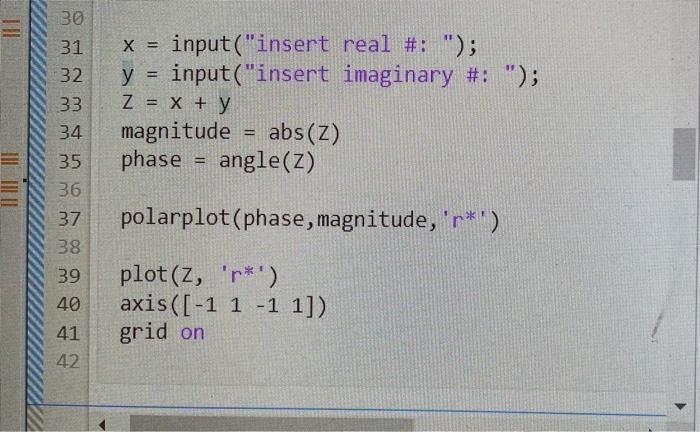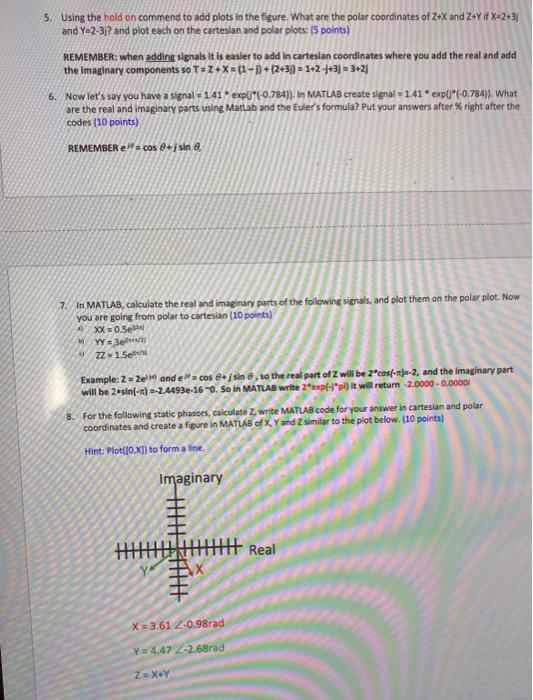Answered step by step
Verified Expert Solution
Question
1 Approved Answer
matlab: this is the code I have so far I need help on the following problems 30 31 32 33 input(insert real #: ); input(insert
matlab: 

30 31 32 33 input("insert real #: "); input("insert imaginary #: "); Z = X + y magnitude = abs(Z) phase angle(Z) polarplot(phase, magnitude, 'r*') 34 35 36 37 38 39 40 41 42 plot(z, '*') axis ([-1 1 -1 1]) grid on 5. Using the hold on commend to add plots in the figure. What are the polar coordinates of 2-X and ZY if X=2+3 and Y-2-3? and plot each on the cartesian and polar plots: 15 points) REMEMBER: when adding signals it is easier to add in cartesian coordinates where you add the real and add the imaginary components so T=24X= (1-1) +(2+3= 1+2+4+3) = 3+2 6. Now let's say you have a signal = 141 expl"(-0.784)). In MATLAB create signal = 141 * expli"(-0.784)). What are the real and imaginary parts using Matlab and the Euler's formula? Put your answers after right after the codes (10 points) REMEMBERE"!= cos 0+; sin e 7. In MATLAB, calculate the real and imaginary parts of the following signals, and plot them on the polar plot. Now you are going from polar to cartesian (10 points) XX 0.5e MYY = 3 22.1.Se Example: 2 = 2e and e= cos 8+ sin 8, so the real part of 2 will be 2*cos(-1)-2, and the imaginary part will be 2-sin(-1) =-2.4493e-16-0. So In MATLAB write 2*exp(-*pil it will return 2.0000 - 0.00001 8. For the following static phasors, calculate 2, write MATLAB code for your answer in cartesian and polar coordinates and create a figure in MATLAB Of X Y and 2 similar to the plot below. (10 points) Hint: Plot([0.X]) to form a line. Imaginary HIT 117 H Real YA X =3.61 Z-0.98rad Y4.47 Z-2.68rad Z = X Y 30 31 32 33 input("insert real #: "); input("insert imaginary #: "); Z = X + y magnitude = abs(Z) phase angle(Z) polarplot(phase, magnitude, 'r*') 34 35 36 37 38 39 40 41 42 plot(z, '*') axis ([-1 1 -1 1]) grid on 5. Using the hold on commend to add plots in the figure. What are the polar coordinates of 2-X and ZY if X=2+3 and Y-2-3? and plot each on the cartesian and polar plots: 15 points) REMEMBER: when adding signals it is easier to add in cartesian coordinates where you add the real and add the imaginary components so T=24X= (1-1) +(2+3= 1+2+4+3) = 3+2 6. Now let's say you have a signal = 141 expl"(-0.784)). In MATLAB create signal = 141 * expli"(-0.784)). What are the real and imaginary parts using Matlab and the Euler's formula? Put your answers after right after the codes (10 points) REMEMBERE"!= cos 0+; sin e 7. In MATLAB, calculate the real and imaginary parts of the following signals, and plot them on the polar plot. Now you are going from polar to cartesian (10 points) XX 0.5e MYY = 3 22.1.Se Example: 2 = 2e and e= cos 8+ sin 8, so the real part of 2 will be 2*cos(-1)-2, and the imaginary part will be 2-sin(-1) =-2.4493e-16-0. So In MATLAB write 2*exp(-*pil it will return 2.0000 - 0.00001 8. For the following static phasors, calculate 2, write MATLAB code for your answer in cartesian and polar coordinates and create a figure in MATLAB Of X Y and 2 similar to the plot below. (10 points) Hint: Plot([0.X]) to form a line. Imaginary HIT 117 H Real YA X =3.61 Z-0.98rad Y4.47 Z-2.68rad Z = X Y this is the code I have so far

I need help on the following problems

Step by Step Solution
There are 3 Steps involved in it
Step: 1

Get Instant Access to Expert-Tailored Solutions
See step-by-step solutions with expert insights and AI powered tools for academic success
Step: 2

Step: 3

Ace Your Homework with AI
Get the answers you need in no time with our AI-driven, step-by-step assistance
Get Started


